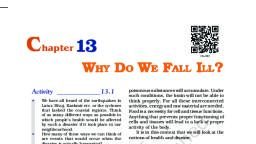Question Text
Question 4 :
Which of the following is the initial step towards good health?
Question 8 :
The ability of individuals to adapt to changes in the environment can be considered as
Question 12 :
The incorrect match among the following regarding the disease and it's symptoms is:
Question 13 :
Which of the following diseases is due to anallergic reaction ?
Question 14 :
.......... practice at regular basis can help reduce risk of various diseases.
Question 15 :
Which of the following is not a common health problem in India?
Question 16 :
Read the given statement and select the option that correctly identifies true (T) and false (F) ones<br>(i) Hepatitis virus primarily affects the liver.<br>(ii) Grave's disease occurs due to hyposecretion of thyroid hormones<br>(iii) Cheilosis occurs due to defficiency of vitamin B<br>(iv) Tuberculosis is a bacterial disease whereas anthrax is a viral disease.
Question 18 :
A parasitic disease which is not transmitted through the bite of an insect is?
Question 24 :
An infectious disease which is vector borne and is transmited to vertebrates by another animal is 
Question 26 :
Ascariasis is a highly prevalent disease caused by an intestinal tapeworm, <i>Taenia solium</i>
Question 30 :
Note the following features and choose the ones applicable to <i>Wuchereia bancrofti.</i><i><br/></i>A) Coelozoic parasite <br/>B) Histozoic parasite<br/>C) Monogenetic parasite<br/>D) Digenetic parasite<br/>E) Monomorphic acoelomate parasite <br/>F) Dimorphic pseudocoelomate parasite
Question 31 :
The fungus that altered the course of history by reducing the population of Ireland from eight million in 1845 to six-million a decade later was:
Question 34 :
Match the diseases / causative organism with its scientist given in list I and II correctly.<br/><table class="wysiwyg-table"><tbody><tr><td></td><td><b>List I</b></td><td></td><td><b>List II</b></td></tr><tr><td>A</td><td>Gonorrhea</td><td>1</td><td>Eberth</td></tr><tr><td>B</td><td>Typhoid</td><td>2</td><td>Klebs</td></tr><tr><td>C</td><td>Diphtheria</td><td>3</td><td>Van Ermengem</td></tr><tr><td>D</td><td>Dysentery</td><td>4</td><td>Shiga</td></tr><tr><td>E</td><td>Botulism</td><td>5</td><td>Neisser</td></tr></tbody></table>
























